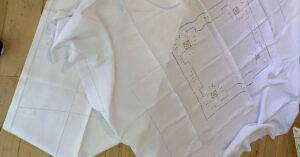 My daughter-in-law Meredith asked for the gift of the early 20th century white Damask banqueting tablecloth once owned by my great-aunt. Perhaps your family set tables this past season using the “canvas” of a fine tablecloth for the “artwork.”
My daughter-in-law Meredith asked for the gift of the early 20th century white Damask banqueting tablecloth once owned by my great-aunt. Perhaps your family set tables this past season using the “canvas” of a fine tablecloth for the “artwork.”
The history of the tablecloth involves art history, the Industrial Revolution, the southern plantation, the invention of the sewing machine, the discovery of artificial dyes, and social status in Europe. Bringing the tablecloth back to 103 AD, the Roman poet Martial mentioned its use in the early Roman dining hall, set on long reclining benches. They called these long measures of linen Mantele. Each Roman carried his own Mappae (napkin). Unless he entertained a Spartan, he carried a piece of dough (apogmadalie) to clean his face and hands. Later this became the tradition of sopping up spills with sliced bread.
Art History Shines Light on Dining Linens
Art history helps locate a date in which most households in Europe used linen for dining. Consider DaVinci’s The Last Supper painted in the late 15th century. Christ and the Apostles dine on Umbrian linen, as fabric historians tell us. Although we cannot surmise the use of linen tablecloths in Christ’s era, we assume general use by the late 15th century. Europeans used tablecloths of white linen or damask. Interestingly, the origins of Italian linens occurred in dressings for the altar. No accident, as DaVinci would’ve known.
We see napkins in late 15th century art as large pieces of cloth, each square devoted to one diner. This changed with the adaptation of the fork, NOT widely used until the 17th century. The neater eating experience rendered by the fork meant napkins became smaller. Etiquette of the 19th century specified a napkin’s size at thirty-five by forty-five inches for formal occasions.
These linens Have a French Origin
Belgian and French linens traditionally required top quality. In 15th century France fabric historians note the use of table linen in the devotional book Tres Riches Heures. In it the Duc de Berry is feted on a white linen banqueting cloth.
From the 15th to 16th century white Damask became de rigor in all royal courts and great family houses in Europe. Flanders became the center for production of Damask (loomed by hand). Buckingham Palace’s banquet table came equipped with seven Damask white tablecloths of 223 feet long each, woven in Flanders. Displays of fine tablecloths appeared at all the World’s Fairs and Expositions throughout Europe.
By the 19th century most upper to middle class households used white linen tablecloths. Etiquette of the day required a six inch drop around all sides for casual dining and up to a fifteen inch drop for formal dining. Art of the 18th and 19th century shows us domestic and courtly scenes using white linen tablecloths, a status symbol. If a household afforded to use white linen tablecloths, they seemed wealthy enough for a laundress. Historians often question the reason for the English tradition of longer, sometimes to the floor, tablecloths. Did they shield the eyes from the ‘sexually explicit’ uncovered LEGS of the table, or did it protect the expensive furniture?
American Textile Revolution
The American South supplied Victorian England with the raw materials to make such tablecloths. They became part of every bride’s list and included in bride’s dowries, and passed down, like my tablecloth. In the mid-19th century the invention of chemically produced synthetic dyes enhanced the English textile industry. Also the invention of the sewing machine allowed the mass production of tablecloths. America rose to prominence in the textile industry through the 19th century after the first textile mill opened in Rhode Island in 1790. The US Government encouraged the rise in textile production by imposing tariffs on imported textiles. Textile mills of the East Coast birthed the American labor movement.
European and American tables enjoyed at least four centuries of white linen, until the mid-19th century English Arts and Crafts movement, which encouraged the philosophy of handwork. Tablecloths are hand embroidered, or made of lace, and NOT white. The subsequent era (Art Nouveau) celebrated color in textiles, especially the softer pastels, and ushered in an artistic respect for design of household objects.
Meredith set a breakfast table on Aunt Frances’s white Damask tablecloth, using my grandmother’s porcelain and her best friend’s silver flatware. I wonder if that tradition is returning.
I dearly hope that this tradition will see a Renaissance. There seems to be quite a few antique shops or such selling wonderful old sets of China going back to the 1800s up until the Lennox of today.. as for me I know the circle goes around. I am holding onto my beautiful Wedgewood service for 14 and my beautiful sterling place settings. which goes back 60 years now. i’ll just pack it up knowing that it doesn’t take up too much space in a basement…. until we have come full circle. Good for your precious daughter-in-law, Meredith..